Choosing the Best Tent for an Air Conditioner
When camping in hot weather, comfort is essential, and choosing the best tent for an air conditioner can make all the difference. Tents designed with air conditioning ports or compatible features offer convenience, effective cooling, and an enhanced outdoor experience. Here, we delve into the importance of AC-compatible tents and the benefits they provide.
Importance of AC-Compatible Tents
AC-compatible tents are specifically designed to integrate air conditioning units seamlessly, ensuring efficient cooling without compromising the tent’s structure or functionality. Here’s why they’re vital:
- Proper Ventilation
AC-compatible tents often feature ventilation flaps or dedicated ports for air conditioning units, allowing for effective airflow and cooling throughout the tent. - Improved Cooling Efficiency
These tents are constructed with materials and designs that retain cool air longer, reducing energy usage and enhancing your camping experience. - Hassle-Free Integration
Unlike standard tents, which may require modifications to accommodate an AC unit, AC-compatible tents are designed to fit various air conditioning models effortlessly, saving time and effort. - Enhanced Durability
AC-compatible tents are often made from sturdy materials that resist wear and tear caused by frequent use of cooling systems.
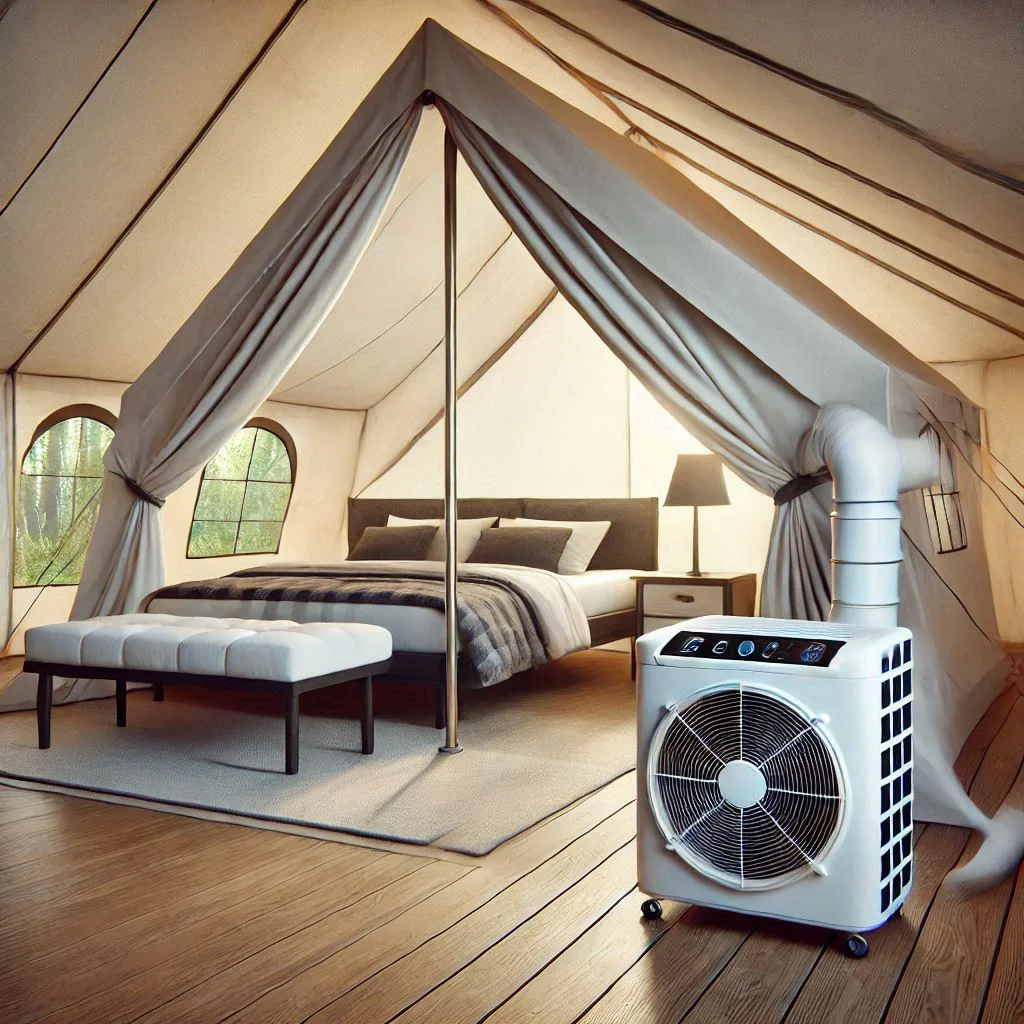
Benefits of Tents with Air Conditioning Ports
- Comfortable Camping in Any Climate
With a tent featuring an AC port, you can enjoy a cool and comfortable retreat even in the hottest environments, ensuring a pleasant night’s sleep. - Energy Efficiency
Air conditioning ports are strategically placed for optimal cooling, reducing the workload on your AC unit and conserving energy. - Versatile Usage
These tents aren’t just for air conditioning units; the ports can also be used for heaters, making them a year-round camping solution. - Reduced Setup Stress
AC-compatible tents simplify the process of connecting and operating an air conditioner, making them ideal for both seasoned campers and beginners. - Family-Friendly Design
Many of these tents are large and accommodate families comfortably, ensuring everyone enjoys a cool and refreshing environment. - Customization Options
High-quality tents offer adjustable ports and additional features like insulated panels, giving you control over your cooling needs.
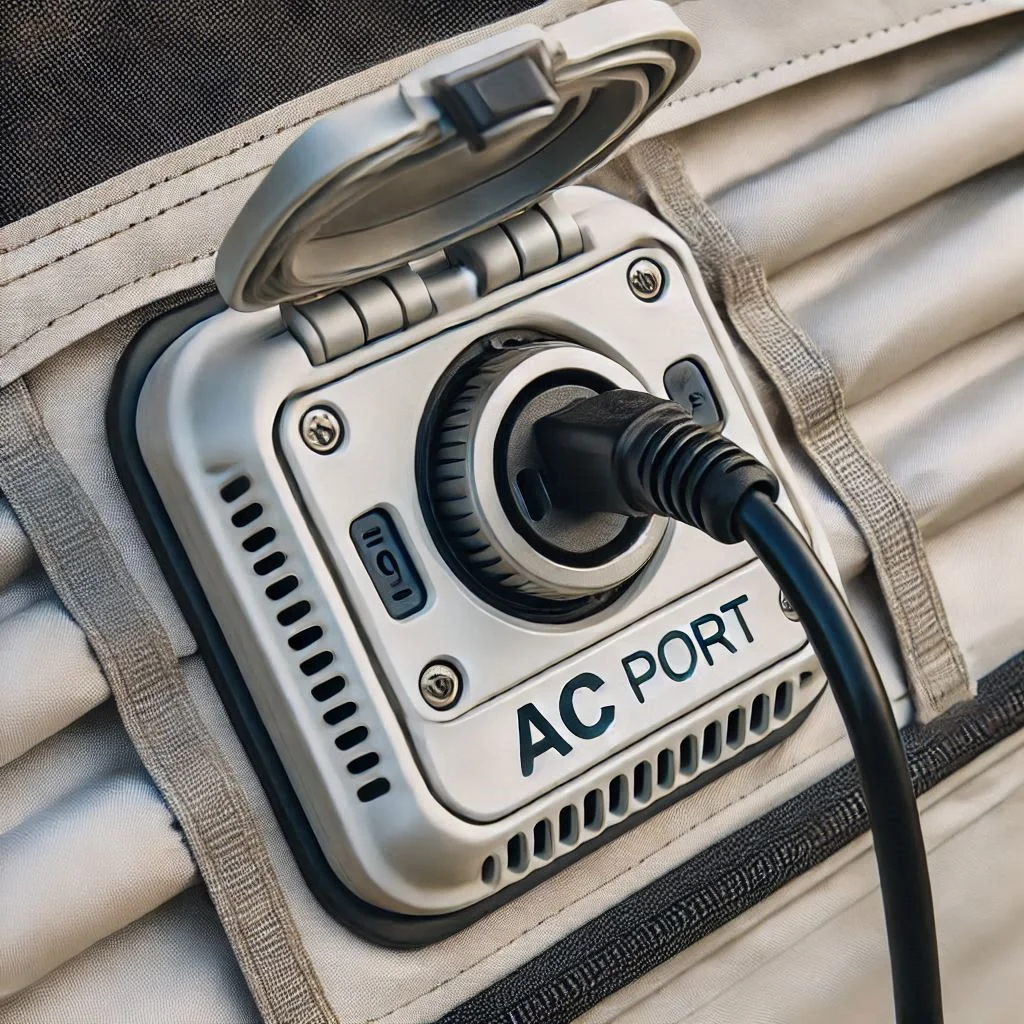
Types of Tents for Air Conditioners
When camping in warmer climates, choosing a tent designed to support air conditioners is a game-changer. Various types of tents cater to different needs, ranging from luxurious setups to budget-friendly options. Below, we explore the key types of tents for air conditioners, ensuring you find the perfect fit for your adventure.
Cabin Tents with AC Ports
Cabin tents are an excellent choice for family camping trips and large groups, offering spacious interiors and built-in AC ports for effortless cooling.
- Spacious and Comfortable
Cabin tents are designed with vertical walls, creating ample headroom and allowing you to stand upright. This design ensures optimal air circulation and efficient cooling when an air conditioner is installed. - Dedicated AC Port Placement
Most cabin tents come with pre-installed AC ports at strategic locations to maximize airflow and cooling efficiency without obstructing the living space. - Perfect for Extended Camping Trips
These tents are durable and well-suited for longer stays, providing a home-like environment with the added benefit of air conditioning.
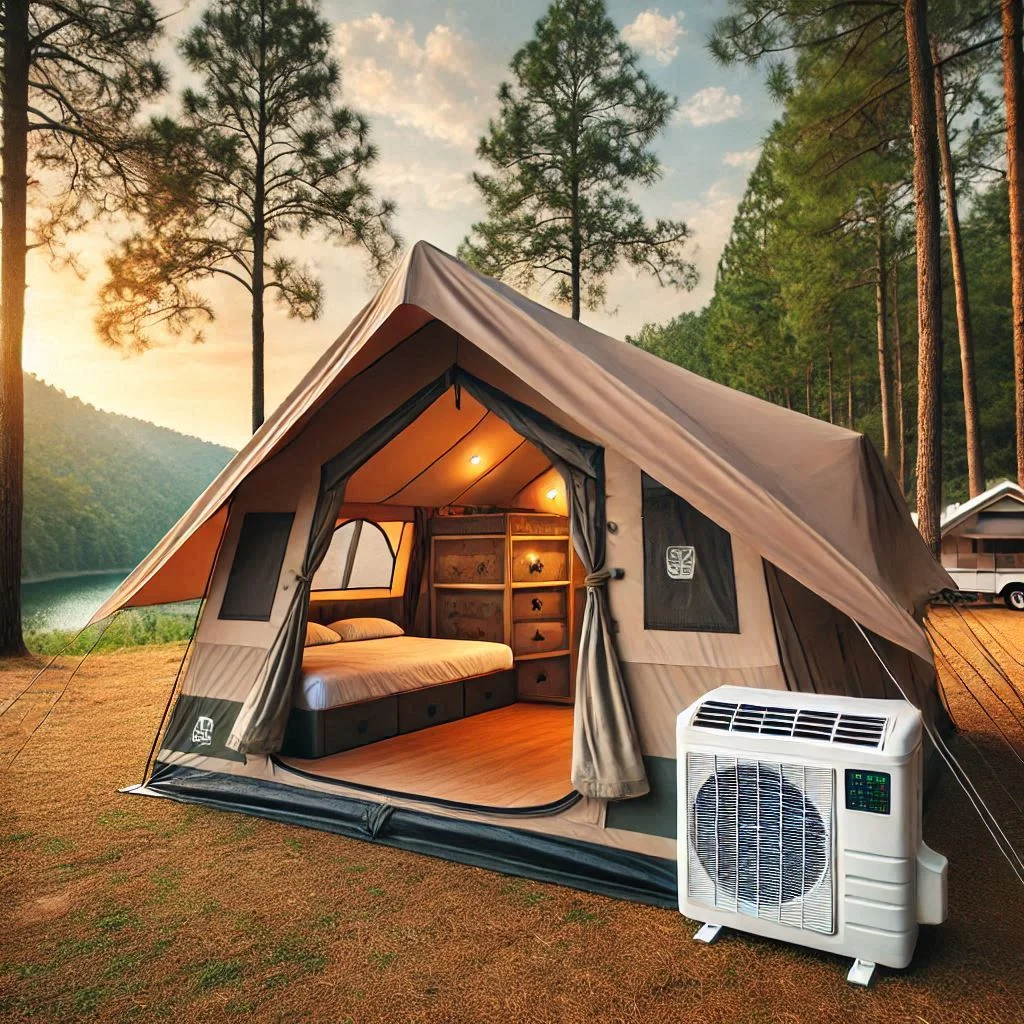
Instant Setup Tents with AC Compatibility
Instant setup tents, also known as pop-up tents, are ideal for campers seeking convenience and functionality.
- Quick and Easy Assembly
These tents feature pre-attached poles and innovative designs that allow them to be set up in minutes, making them perfect for beginners and short camping trips. - Built-In AC Ports for Comfort
Despite their quick setup, instant tents don’t compromise on cooling features. Many models include AC-compatible ports or ventilation panels to accommodate portable air conditioners. - Portable and Lightweight
Instant setup tents are compact and lightweight, making them easy to carry and transport to your campsite.
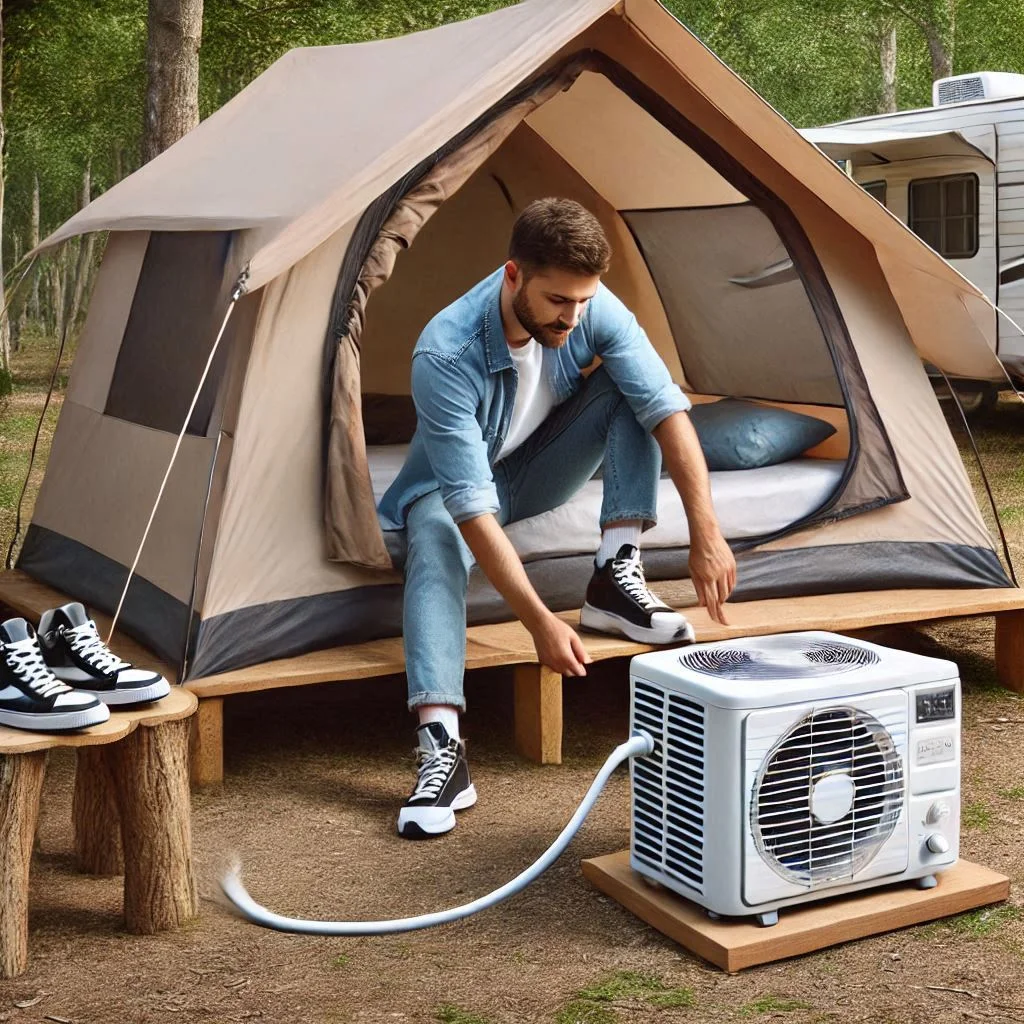
Budget-Friendly Tents with AC Features
For campers on a budget, there are affordable options that still offer essential features like AC ports and cooling compatibility.
- Cost-Effective Cooling
Budget-friendly tents are designed to provide a comfortable camping experience without breaking the bank. While they may lack advanced features, they include basic AC compatibility for cooling. - Compact and Functional Design
These tents are often smaller but make efficient use of space, ensuring the air conditioner cools the interior effectively. - Best for Occasional Use
If you’re a casual camper, these tents are a practical choice, offering the comfort of air conditioning at a fraction of the cost.
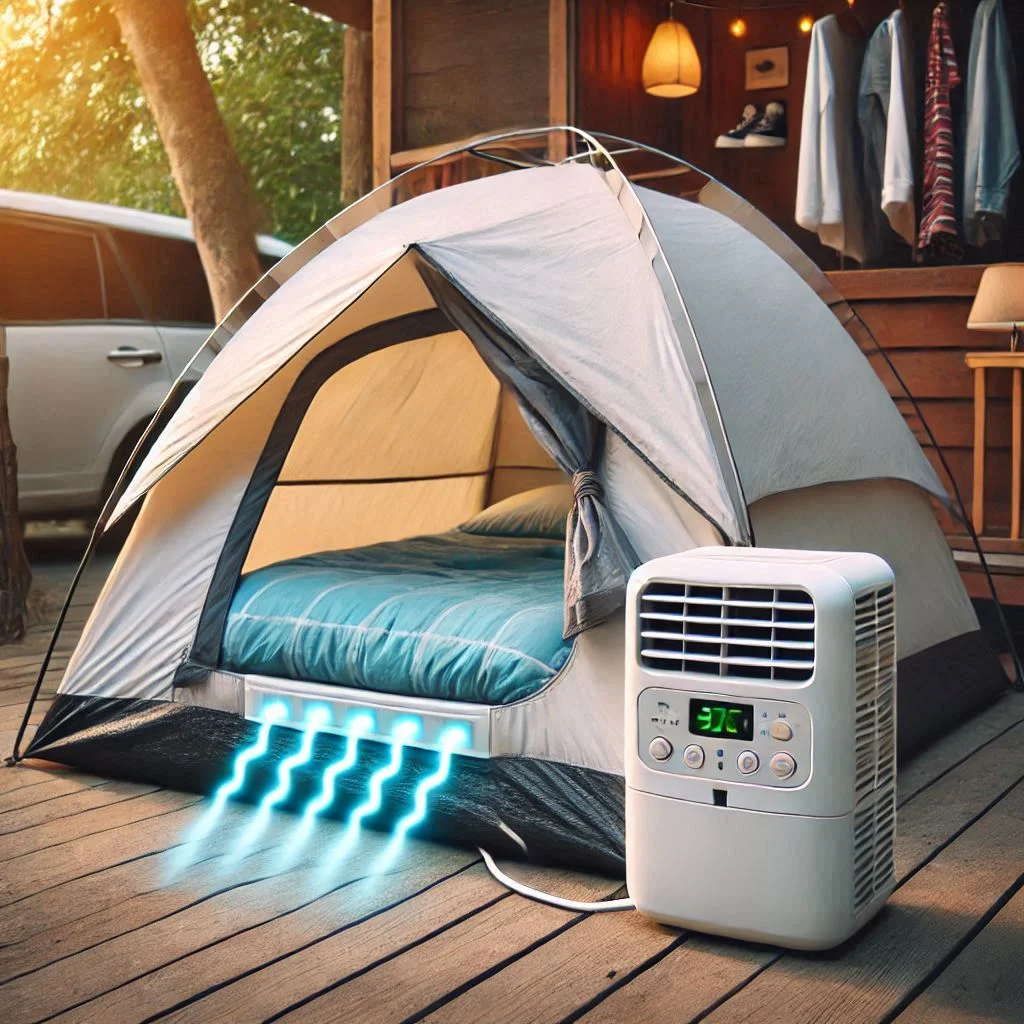
Top Tent Air Conditioner Options
Choosing the right air conditioning unit for your tent is vital to ensure a comfortable camping experience in hot weather. Different types of AC units cater to various camping setups, offering unique features and cooling capacities. Here’s a detailed guide to the top tent air conditioner options.
Portable AC Units for Tents
Portable air conditioners are versatile, compact, and specifically designed for on-the-go cooling, making them an excellent choice for tent camping.
- Compact and Lightweight
These units are easy to transport and set up, ideal for campers who need efficient cooling without carrying bulky equipment. - Self-Contained Cooling
Portable ACs combine cooling and dehumidifying functions, creating a more comfortable environment inside your tent. - Battery-Powered Options
Some portable units are battery-powered, providing flexibility for off-grid camping trips. Advanced models even include rechargeable batteries or solar compatibility.
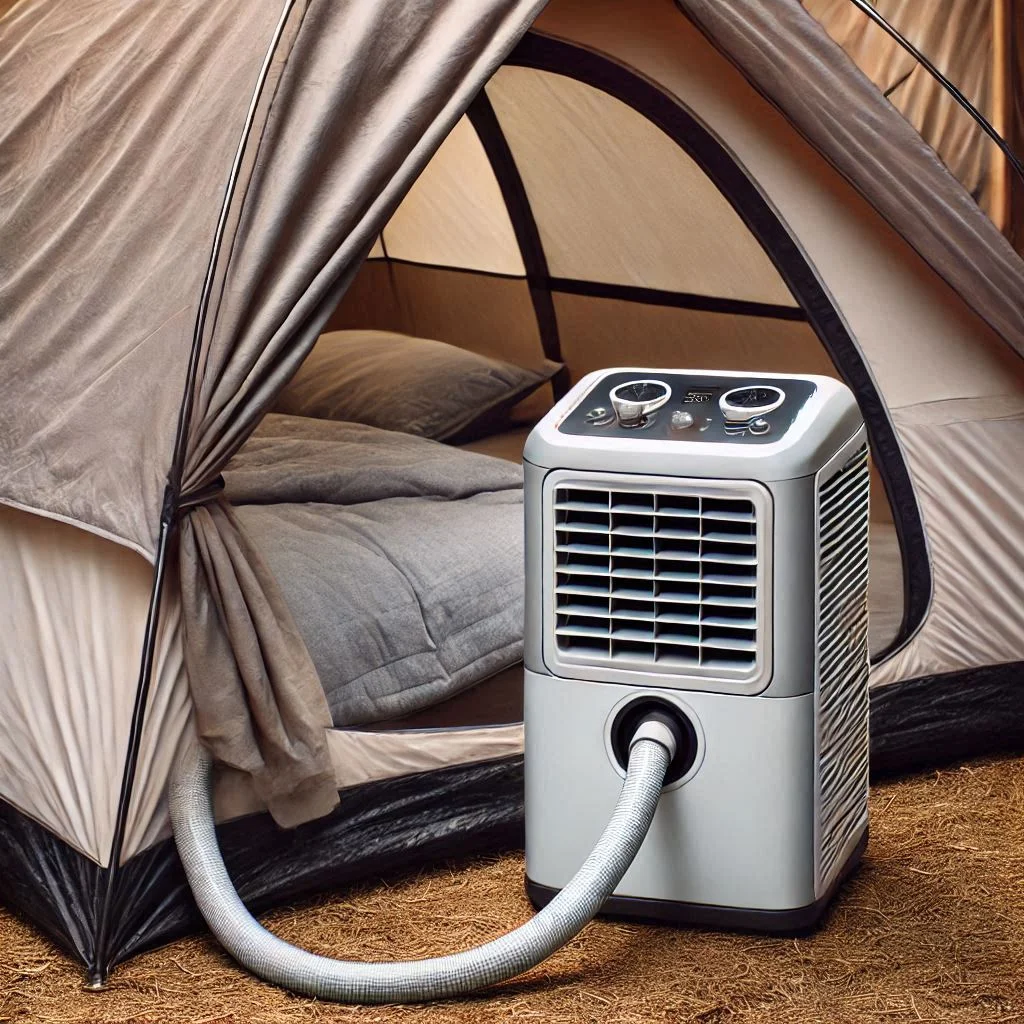
Window AC Units
Window air conditioners, though traditionally designed for homes, can be adapted for tent use with proper setup and support.
- High Cooling Capacity
Window units are powerful, offering superior cooling for larger tents or multiple occupants. They’re perfect for family camping trips where comfort is a priority. - Cost-Effective Performance
These units are generally more affordable compared to other options, delivering excellent cooling at a lower cost. - Requires Sturdy Support
Window AC units need a secure installation frame or platform to function effectively with a tent. Many tents with AC ports are designed to accommodate this setup.
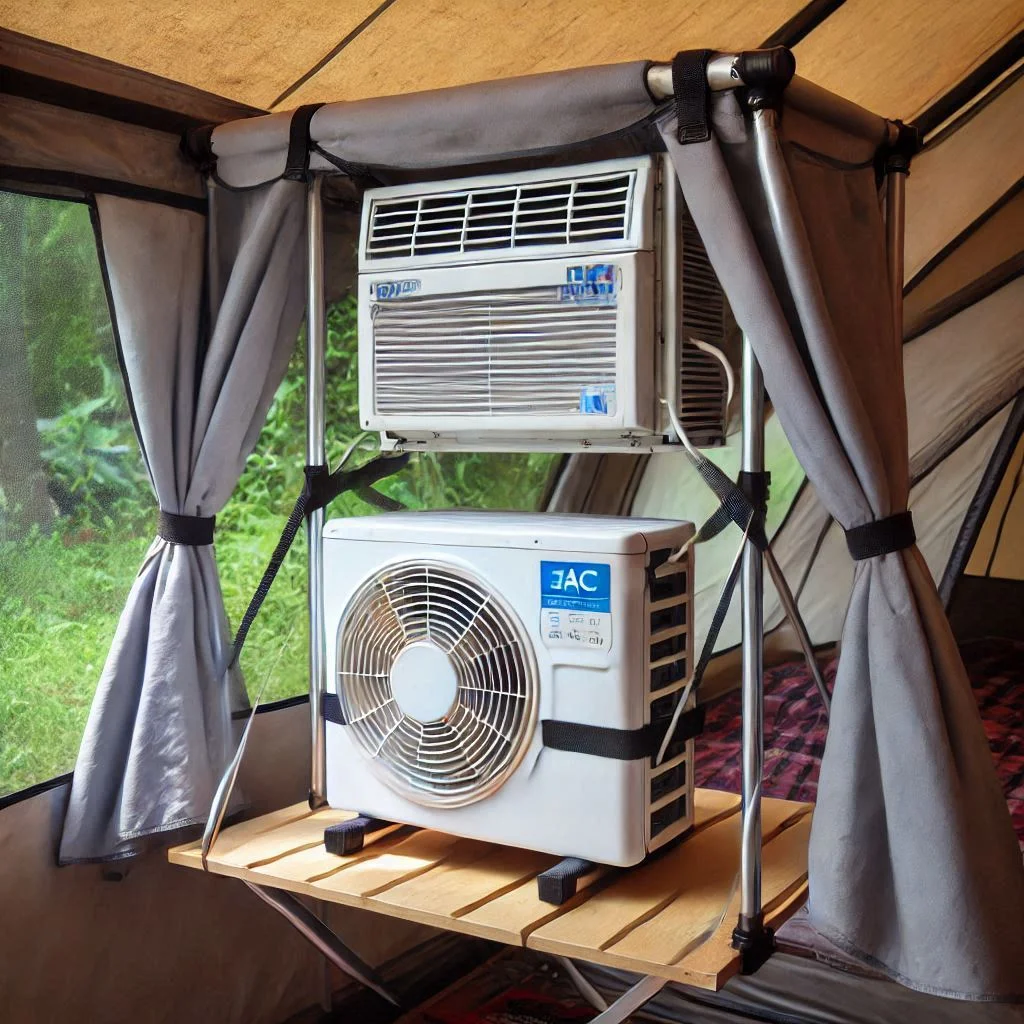
Evaporative Coolers
Evaporative coolers, also known as swamp coolers, are energy-efficient and eco-friendly options for tent cooling.
- Water-Based Cooling
These units use water evaporation to lower the temperature, making them highly efficient in dry, hot climates. - Low Power Consumption
Evaporative coolers consume significantly less energy than traditional AC units, ideal for campers with limited power sources. - Portable and Affordable
These lightweight units are budget-friendly and easy to transport, making them suitable for casual campers looking for a cost-effective cooling solution.
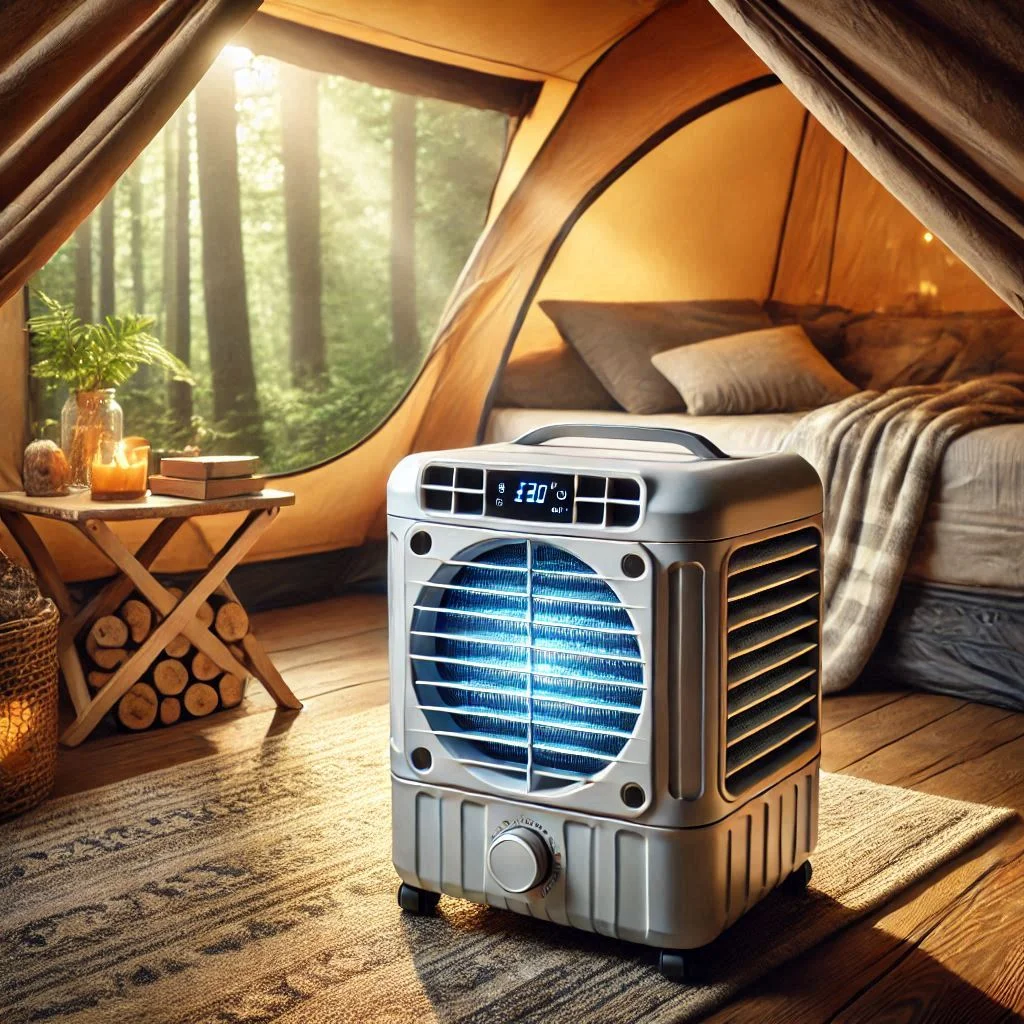
Best Tent Models with AC Ports
Selecting a tent equipped with AC ports can significantly enhance your camping experience, especially during warm weather. Below, we explore some of the best tent models with AC ports, each offering unique features for different camping preferences.
Ozark Trail Three Room Instant Cabin: Best Overall
The Ozark Trail Three Room Instant Cabin stands out as the ultimate choice for comfort, space, and versatility.
- Spacious Design
This tent offers three separate rooms, accommodating up to 12 people, making it perfect for family camping trips or group outings. - Built-In AC Port
The tent features a pre-installed AC port that is strategically positioned to ensure optimal airflow and cooling throughout the interior. - Easy Setup
With its instant cabin design, the tent can be set up in under two minutes, allowing you to focus on enjoying your trip rather than struggling with assembly.
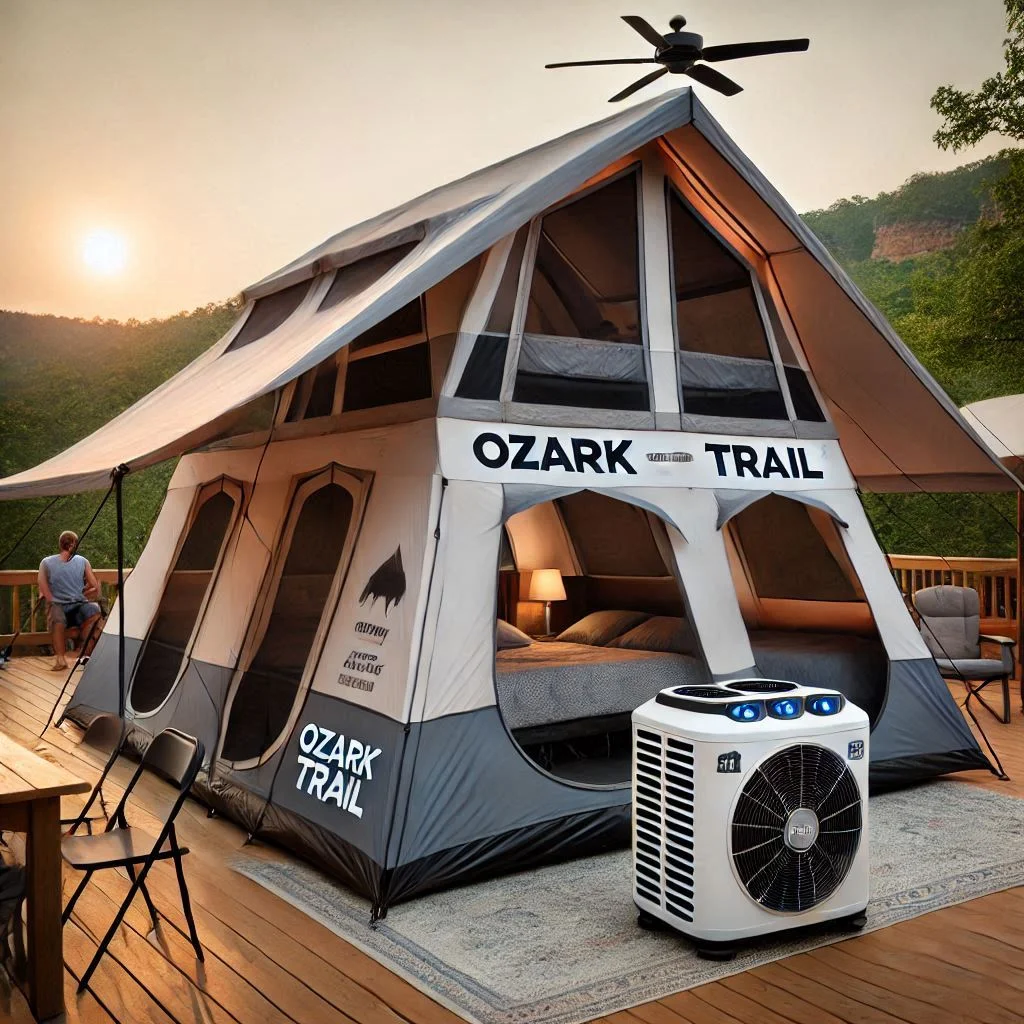
Bushnell Shield 12 Person Tent: Premium Quality
For those seeking a premium camping experience, the Bushnell Shield 12 Person Tent delivers unmatched quality and durability.
- Weather-Resistant Construction
Made with high-quality materials, this tent is designed to withstand harsh weather conditions, ensuring a safe and comfortable environment. - Multiple AC Ports
It includes dual AC ports, allowing for enhanced cooling options and greater flexibility in positioning your air conditioning unit. - Enhanced Ventilation
The tent features multiple mesh windows and ground vents, complementing the AC system for superior airflow.
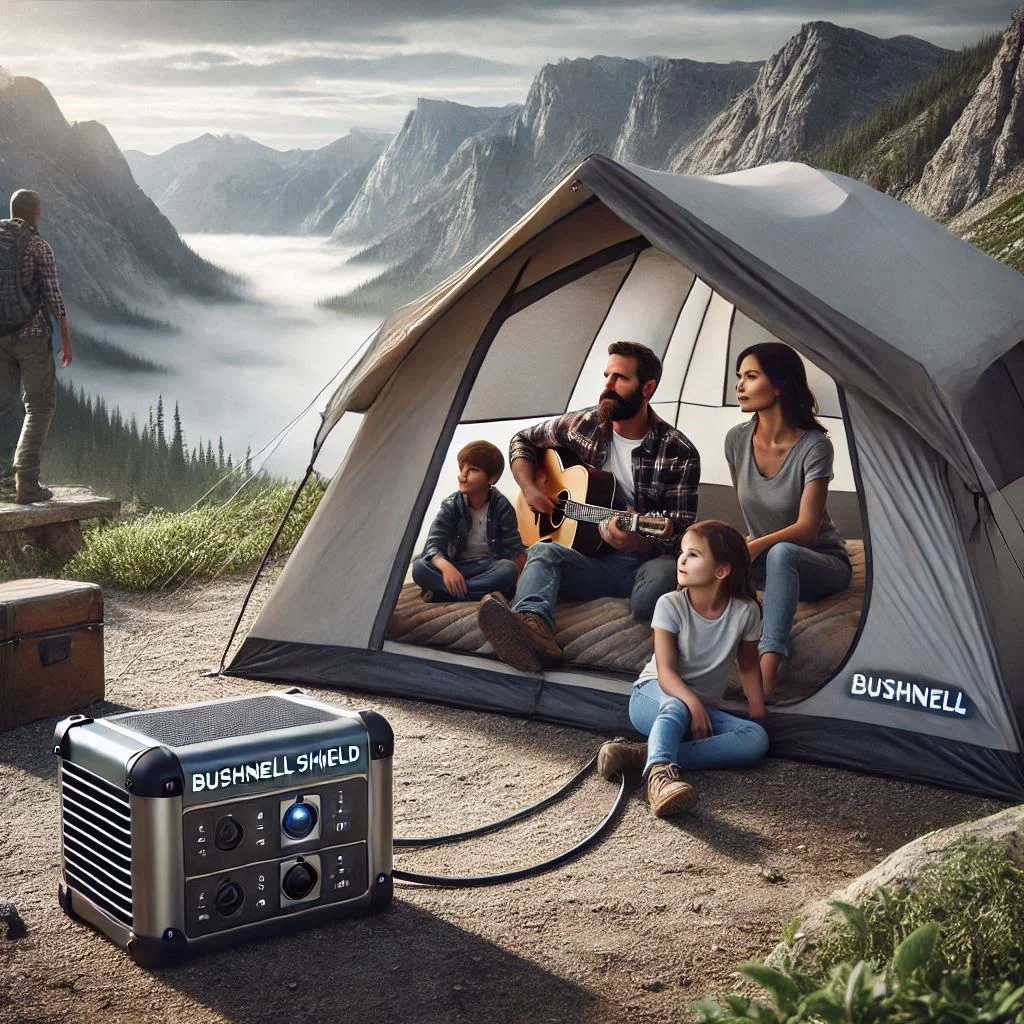
Wenzel Klondike 8 Person Tent: Budget Pick
The Wenzel Klondike Tent is a budget-friendly option that doesn’t compromise on essential features.
- Compact Yet Functional
This tent comfortably sleeps up to 8 people and includes a screened-in porch for additional space. - AC Port Compatibility
While affordable, the tent is equipped with an AC port, making it an excellent choice for campers looking to stay cool without spending a fortune. - Lightweight and Portable
Easy to transport and set up, this tent is ideal for weekend getaways or casual camping trips.
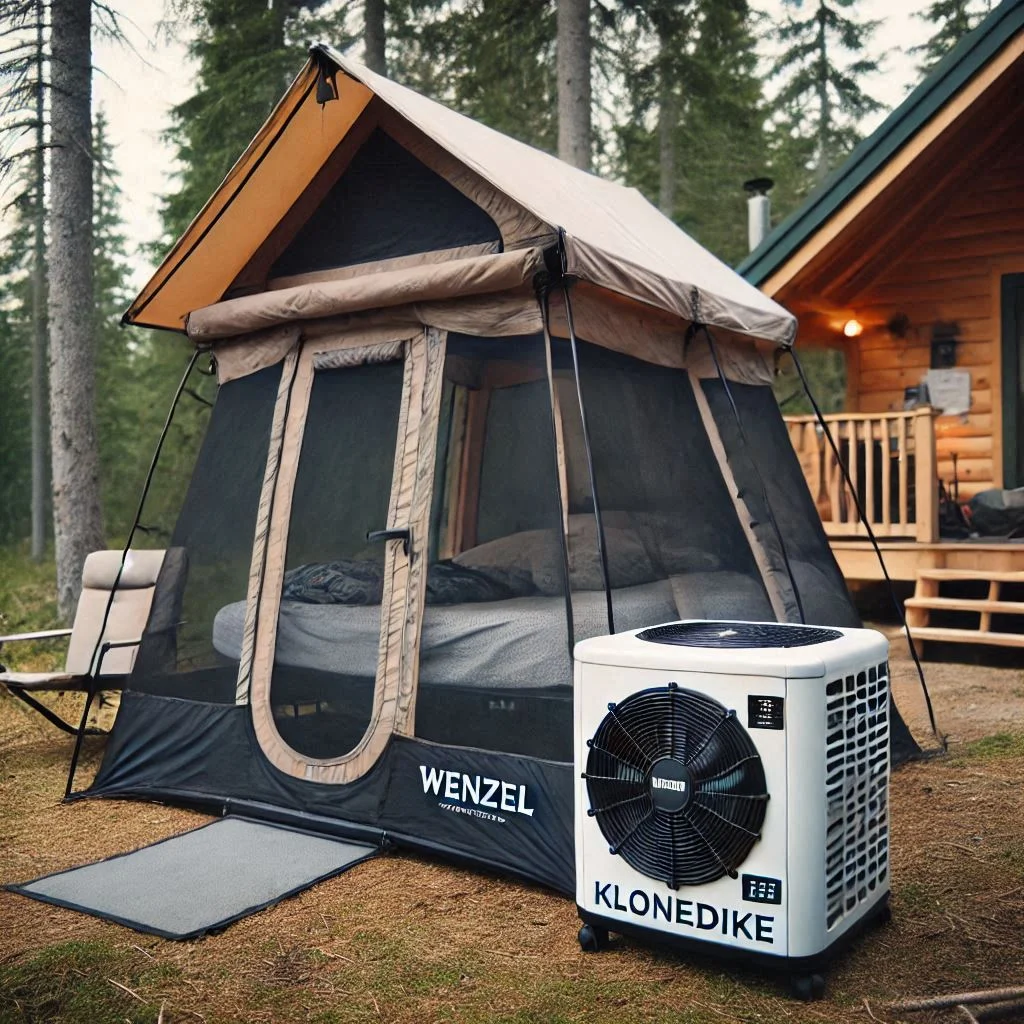
Core 12 Person Instant Cabin
The Core 12 Person Instant Cabin combines spaciousness with convenience, making it a favorite for large groups.
- Extra-Large Interior
With room to accommodate up to 12 people, this tent is perfect for family reunions or group camping adventures. - Integrated AC Port
The AC port is designed for hassle-free installation of cooling units, ensuring consistent airflow and a pleasant environment inside the tent. - Quick Assembly
The instant setup design allows the tent to be pitched in under two minutes, saving you time and effort.
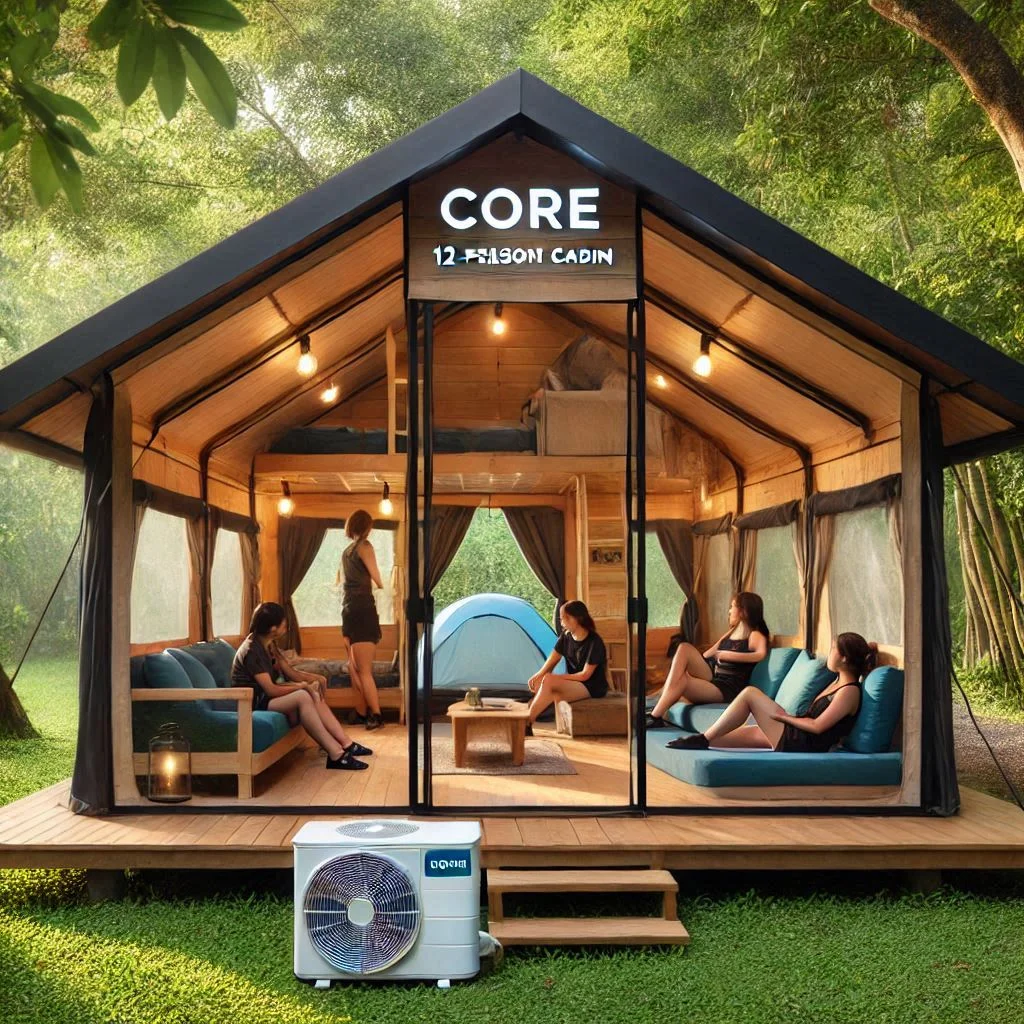
Tips for Using a Tent with an Air Conditioner
Properly utilizing an air conditioner in your tent can elevate your camping experience, ensuring comfort even in the hottest conditions. Below are key tips for maximizing the efficiency and functionality of your tent air conditioning setup.
Ventilation and Positioning
Optimizing airflow and strategically positioning your air conditioner is crucial for effective cooling.
- Strategic Placement
Position the air conditioner near the tent’s designated AC port or window. This ensures that cool air is distributed evenly throughout the interior. - Enhancing Air Circulation
Use built-in vents or mesh windows to improve airflow. Opening windows slightly on the opposite side of the AC unit allows warm air to escape while the cool air circulates. - Sealing Gaps
Ensure the AC port or opening is properly sealed around the unit. This prevents cool air from escaping and warm air from entering the tent.
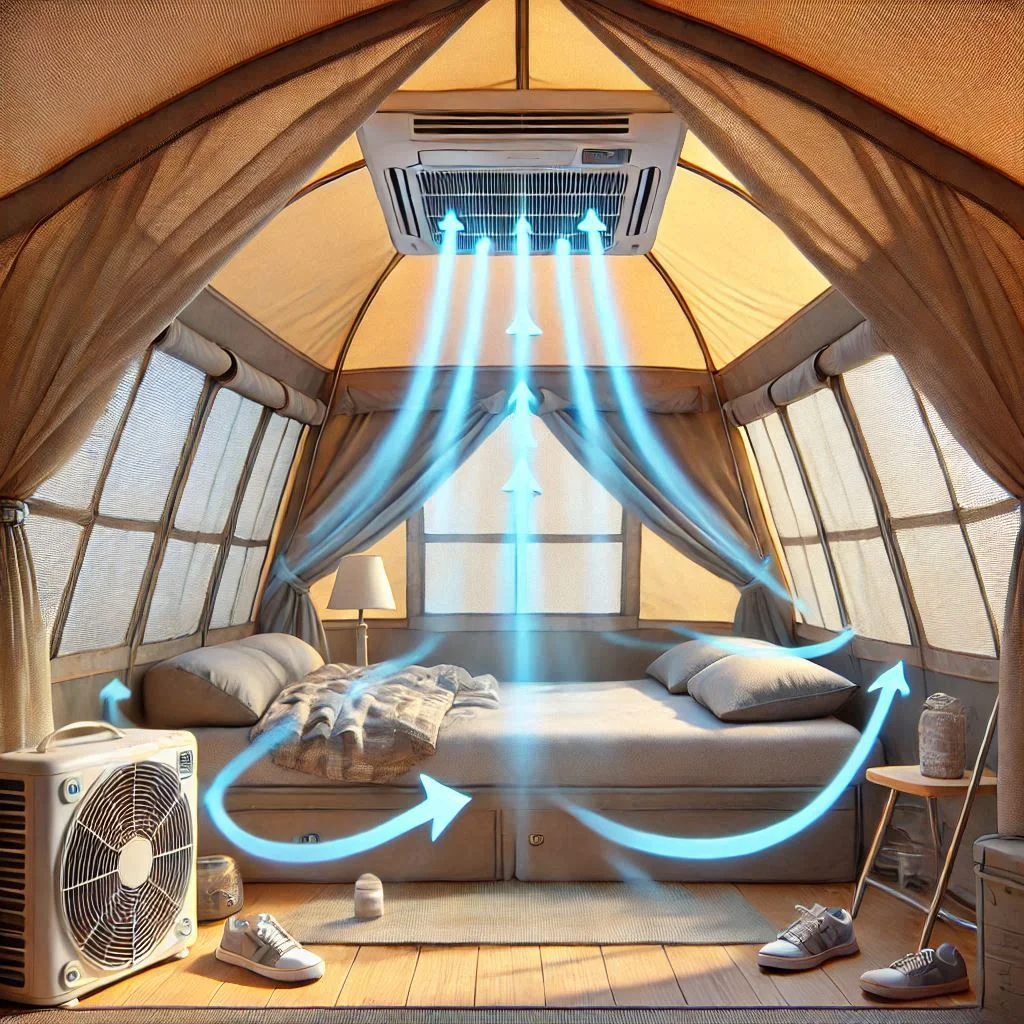
Insulation for Maximum Efficiency
Effective insulation can drastically improve your tent’s cooling performance by minimizing heat gain and maximizing energy efficiency.
- Use Reflective Tarps or Covers
Place a reflective tarp over the tent to deflect sunlight and reduce internal heat buildup. - Insulate the Tent Floor
Lay foam mats, insulated blankets, or rugs on the tent floor to prevent heat from seeping through the ground. - Block Unused Openings
Seal off unused windows or vents with thermal covers to retain cool air within the tent.
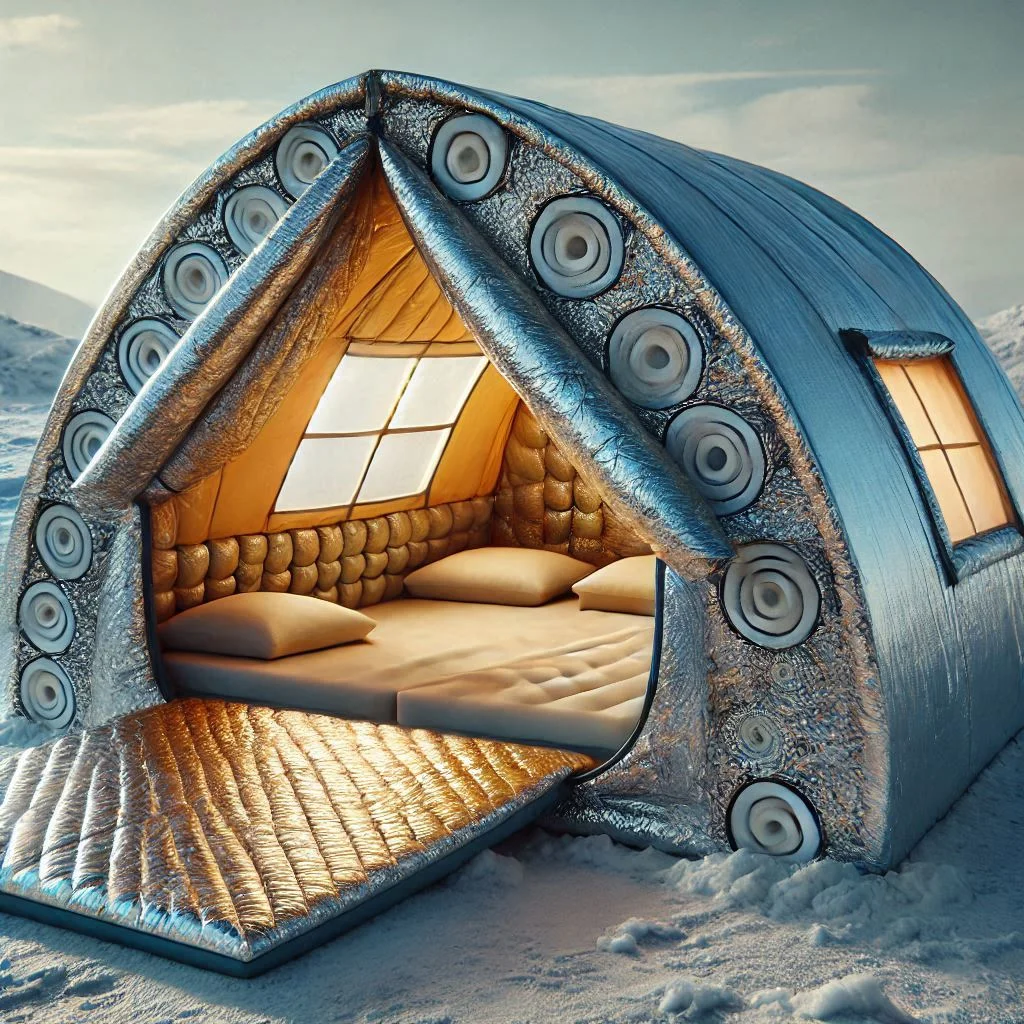
Choosing the Right Cooling Capacity
Selecting an air conditioner with the appropriate cooling capacity ensures your tent stays comfortable without overloading the system.
- Understand BTU Ratings
The BTU (British Thermal Unit) rating determines how much space an AC unit can effectively cool. For example:- Small tents: 5,000–8,000 BTUs.
- Medium tents: 10,000–12,000 BTUs.
- Large tents: 14,000+ BTUs.
- Consider Tent Size and Occupancy
Account for the number of occupants and additional heat sources (e.g., electronics or cooking appliances) when choosing the AC unit’s capacity. - Energy Efficiency
Opt for energy-efficient models to conserve power, especially when camping off-grid or using limited power sources.
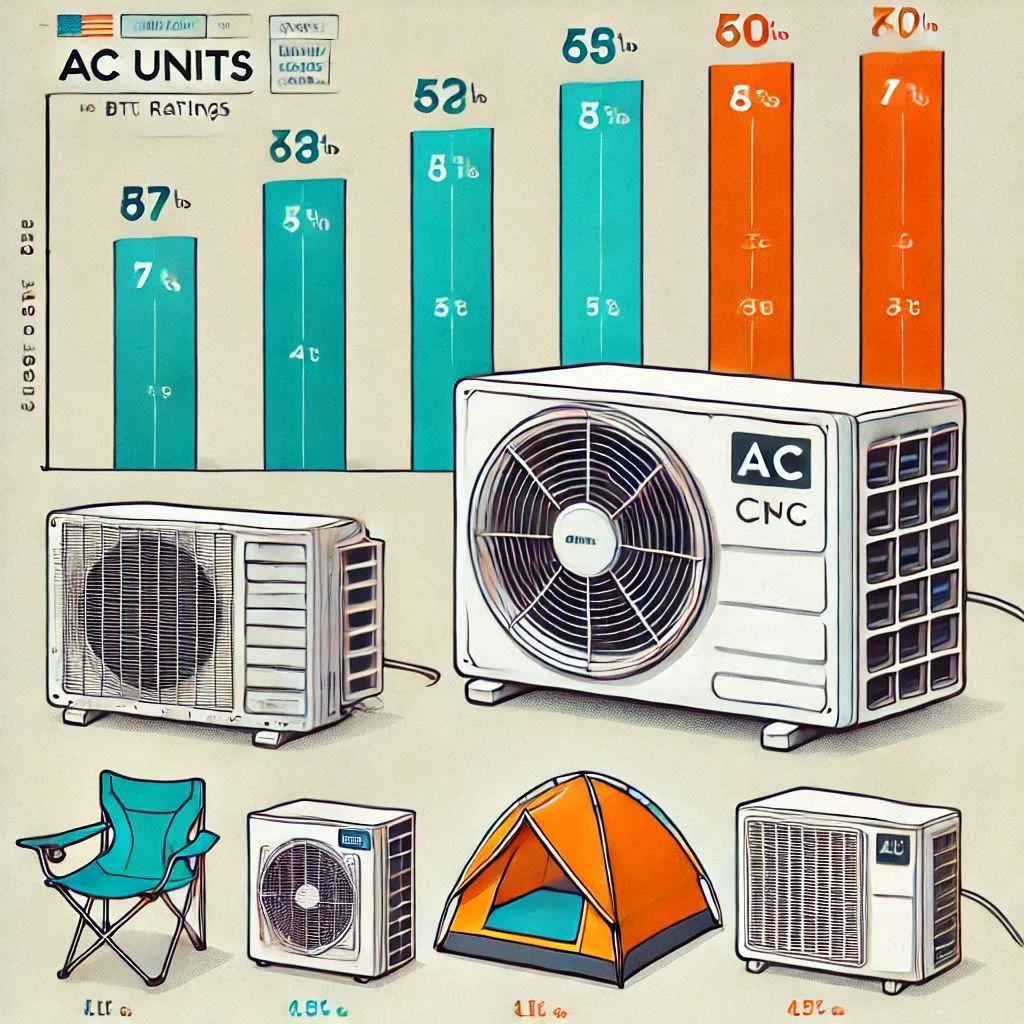
Maintenance and Alternative Cooling Solutions
Proper maintenance of your tent air conditioner is crucial for its longevity and efficiency. Additionally, exploring alternative cooling methods can complement your AC setup or serve as standalone solutions in specific situations.
Cleaning and Storing Your Tent AC
Regular upkeep of your air conditioner ensures optimal performance and extends its lifespan.
- Routine Cleaning
- Clean the Filters: Remove and clean the filters regularly to prevent dust and debris buildup, which can reduce airflow and efficiency.
- Wipe the Exterior: Use a damp cloth to clean the AC unit’s outer surfaces, ensuring there’s no dirt or residue blocking vents or controls.
- Drain and Dehumidify
- Empty the water reservoir (if applicable) after each use to prevent mold and bacteria growth.
- For units with dehumidifier functions, ensure they are dry before storage.
- Safe Storage
- Store the AC unit in a dry, cool place during the off-season.
- Use a protective cover to shield the unit from dust and potential damage.
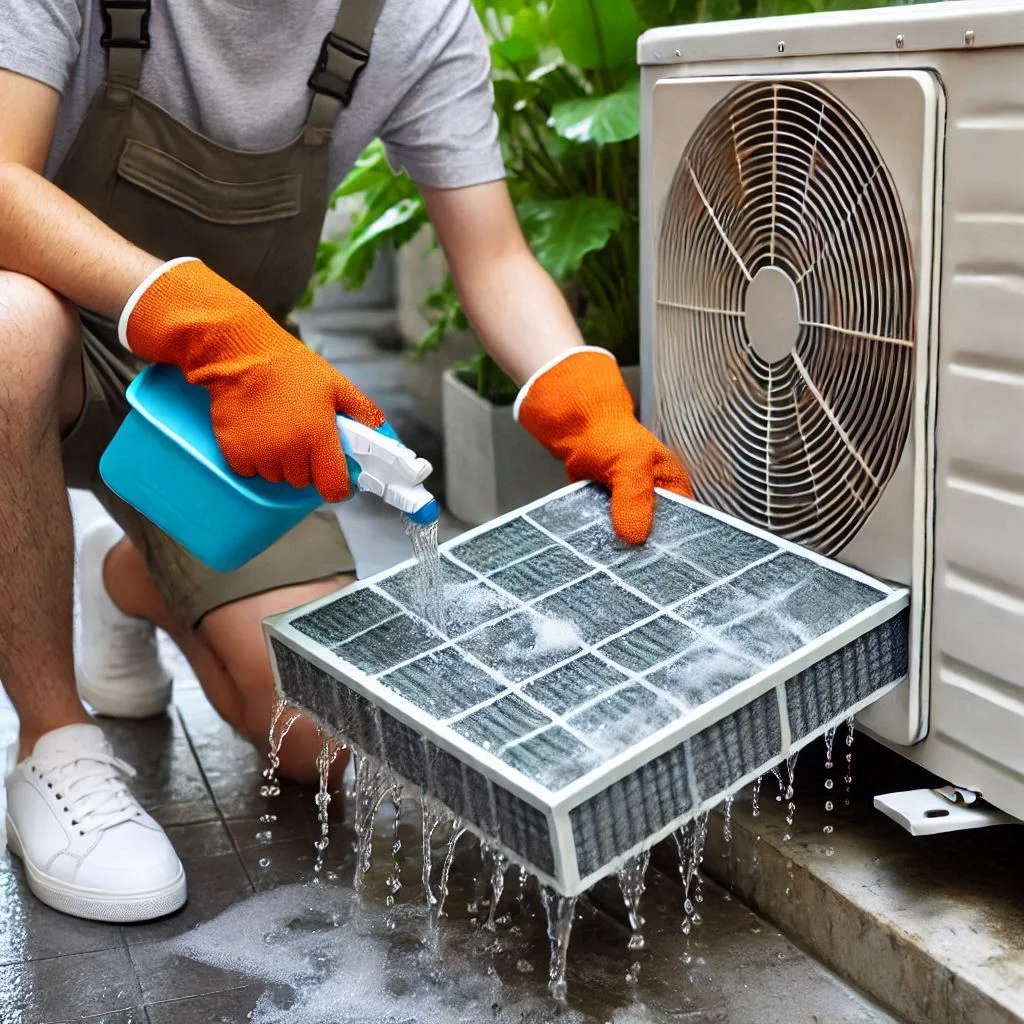
Fans and Natural Ventilation Techniques
If an air conditioner isn’t an option or you need additional cooling, fans and natural ventilation can help regulate the tent’s temperature effectively.
- Portable Fans
- Use rechargeable or battery-operated fans for direct airflow.
- Position fans strategically to enhance ventilation, such as near the tent’s entrance or windows.
- Natural Ventilation
- Maximize Airflow: Open mesh windows, doors, and vents to encourage cross-ventilation.
- Strategic Tent Placement: Set up your tent in a shaded area or near a water source to take advantage of cooler surroundings.
- DIY Cooling Methods
- Hang damp towels near openings to create a cooling effect as the air passes through them.
- Place ice packs in front of fans for a makeshift cooling system.
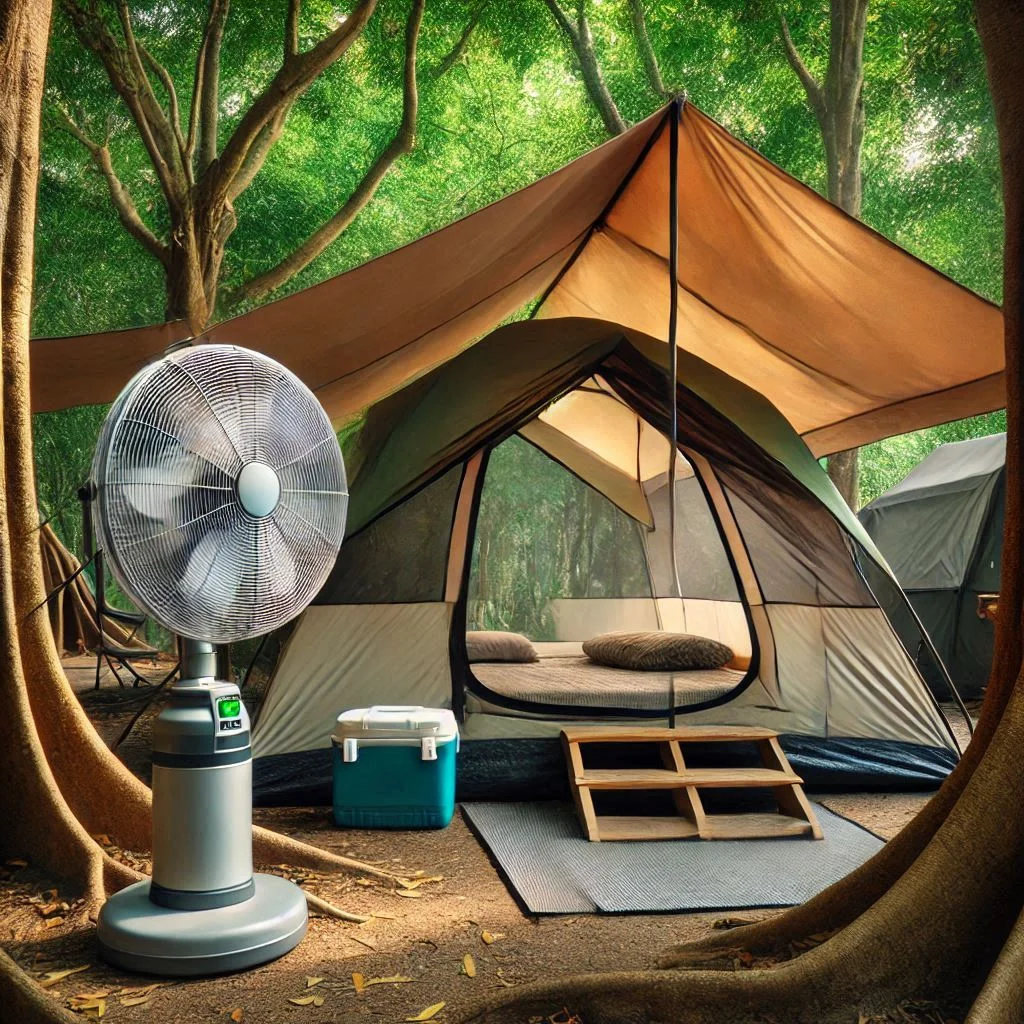
FAQs: Best Tent for Air Conditioner
Camping with an air conditioner raises several questions about compatibility, insulation, and alternative cooling methods. Below are detailed answers to some of the most frequently asked questions about finding and using the best tent for an air conditioner.
What Type of Tent Is Best for Air Conditioners?
The best tents for air conditioners are those designed with AC compatibility in mind.
- Cabin Tents with AC Ports
- These tents come with pre-installed AC ports or windows, making it easy to set up an air conditioner.
- They often feature enhanced ventilation systems to support air circulation.
- Instant Tents
- Instant setup tents are perfect for quick assembly and often include features like built-in AC ports or mesh windows to facilitate cooling.
- Durable and Spacious Designs
- Look for tents made with thick materials that provide better insulation and adequate space to fit the AC unit without cramping the interior.
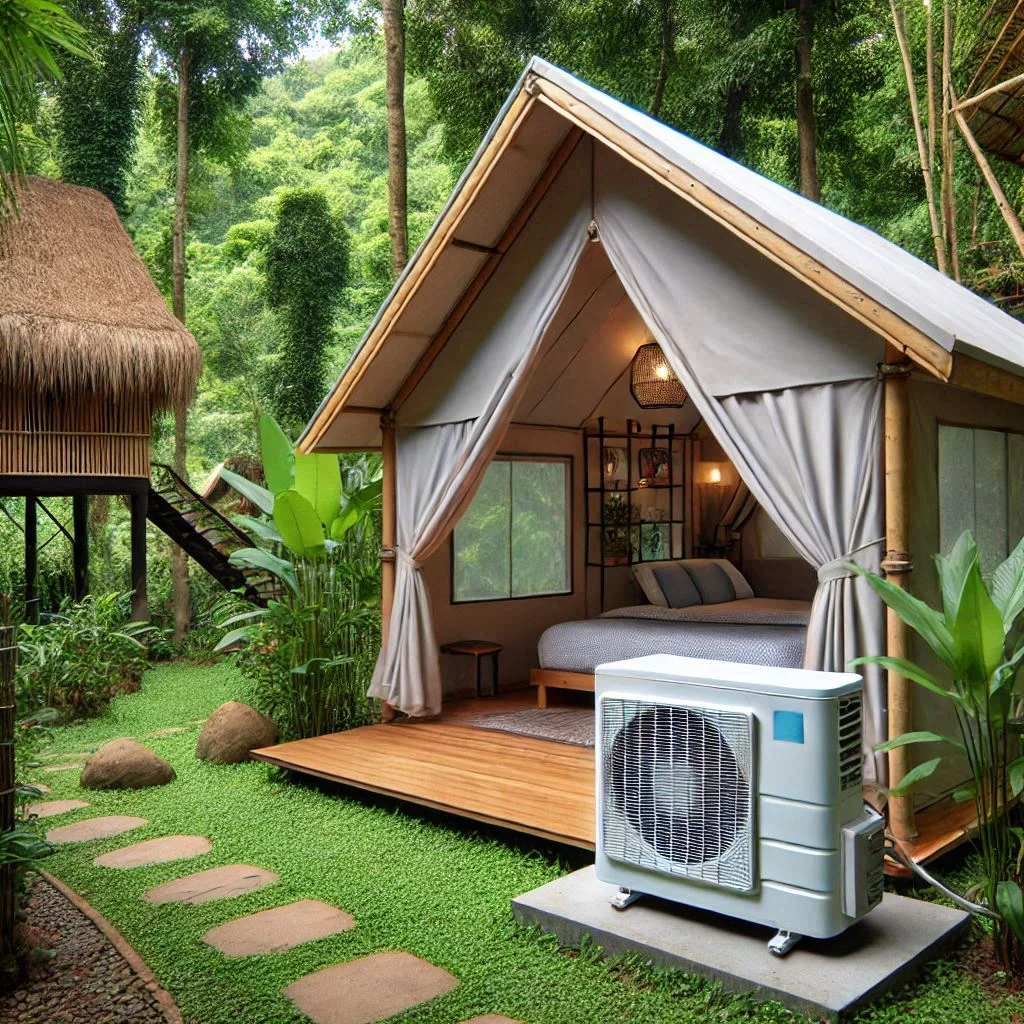
Can Any Tent Be Used with an Air Conditioner?
While it’s technically possible to use an AC with any tent, certain conditions must be met for it to work effectively.
- Size Matters
- Smaller tents are easier to cool but may lack AC ports, requiring modifications.
- DIY Modifications
- For tents without AC ports, you can create your own opening using a heat-resistant fabric to ensure a snug fit around the AC unit.
- Ventilation and Sealing
- Proper ventilation is essential for effective cooling, but openings must be sealed well to prevent air leaks.
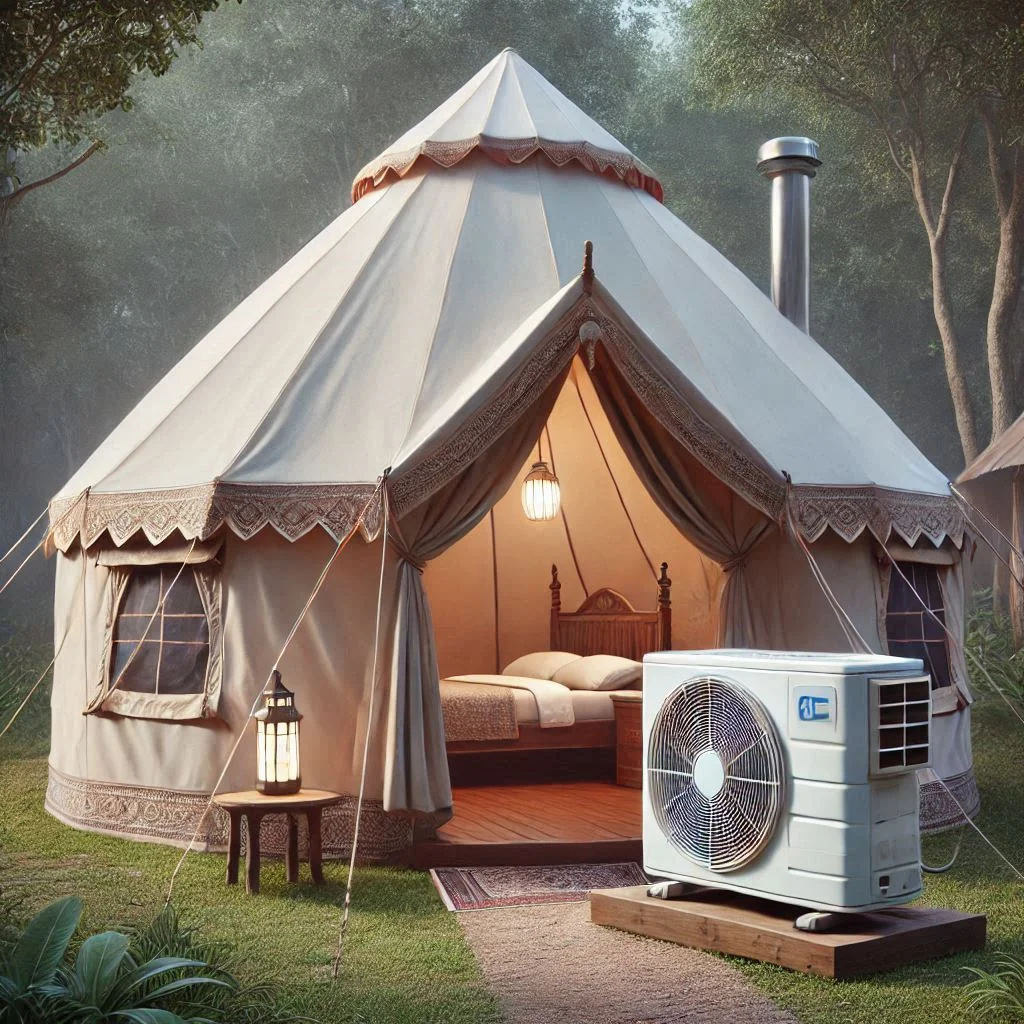
How Do I Insulate My Tent for Better Cooling?
Insulating your tent enhances cooling efficiency and ensures the air conditioner works effectively.
- Reflective Covers
- Use a reflective tarp over the tent to block sunlight and reduce heat buildup.
- Seal Openings
- Close unused vents or windows with thermal covers to retain cool air inside.
- Insulate the Ground
- Lay foam mats or insulated blankets on the floor to prevent heat transfer from the ground.
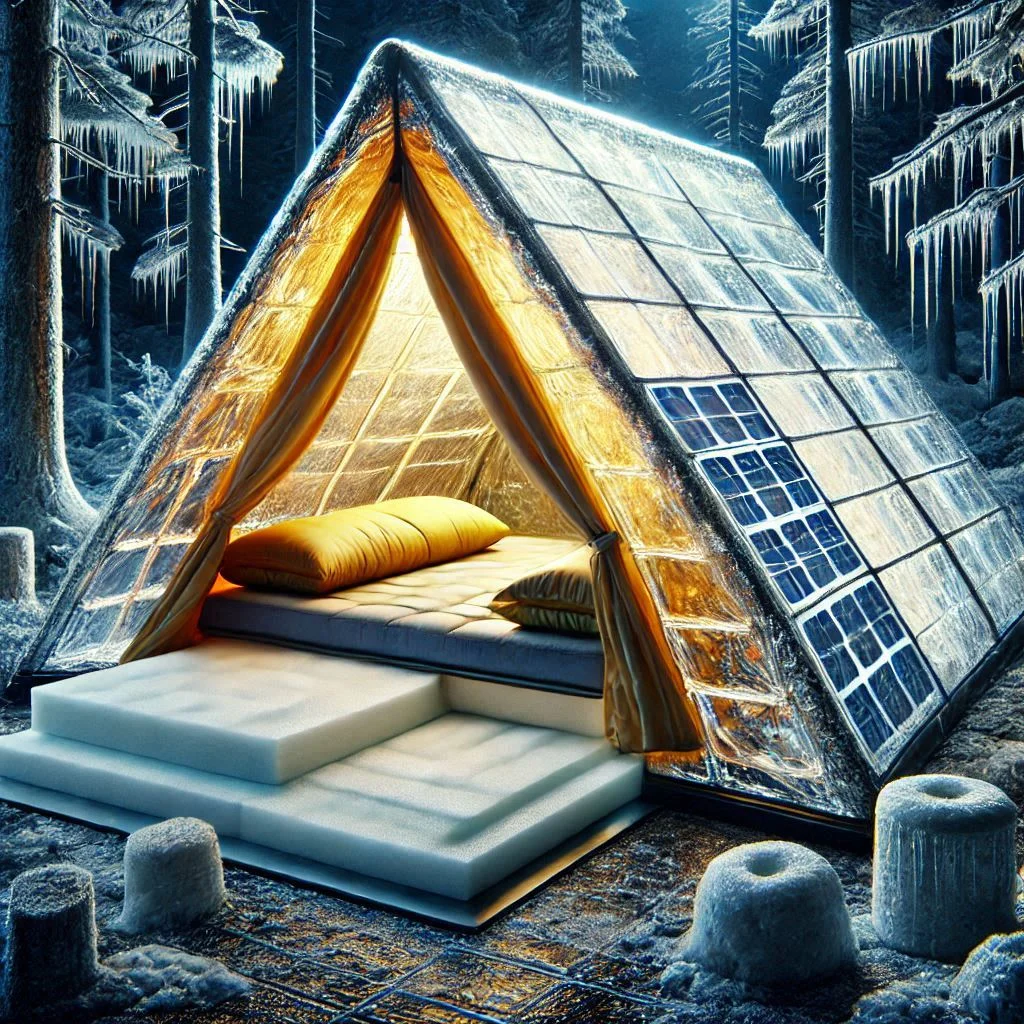
Are There Portable AC Units Specifically Designed for Tents?
Yes, several portable AC units are tailored for tent use.
- Lightweight and Compact Models
- Units like the Zero Breeze Mark 2 are compact, lightweight, and designed for outdoor use.
- Battery-Operated Options
- Some models run on rechargeable batteries, making them ideal for camping off-grid.
- Dual Functionality
- Many tent-friendly AC units double as dehumidifiers, reducing humidity and enhancing comfort.
What Are Alternative Cooling Options for Tents Without AC Ports?
If your tent doesn’t have an AC port, consider these cooling methods:
- Portable Fans
- Battery-operated fans can provide directed airflow, especially when used with damp towels or ice packs.
- Evaporative Coolers
- These are compact devices that use water to cool the air and are ideal for dry climates.
- Natural Cooling Techniques
- Set up the tent in a shaded area or near a water source to naturally reduce heat.
- Open windows and vents for cross-ventilation.
Conclusion
Choosing the best tent for an air conditioner ensures a comfortable and enjoyable camping experience, no matter the weather. By understanding the various types of AC-compatible tents, selecting the right air conditioner, and implementing effective cooling and insulation techniques, you can create a refreshing haven in the great outdoors. From spacious cabin tents with dedicated AC ports to portable units tailored for tent use, there are options to suit every need and budget. For those without AC access, alternative cooling methods like fans and evaporative coolers provide practical solutions. With proper maintenance and smart camping strategies, your tent can remain cool and comfortable throughout your adventures.

